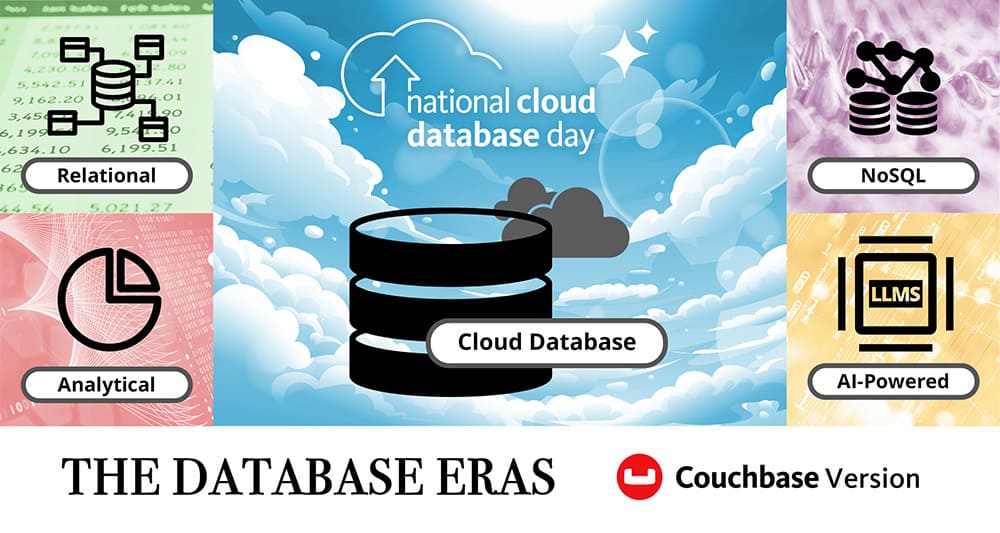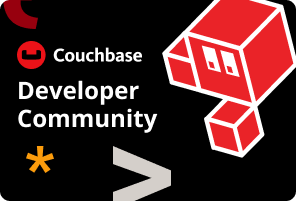Couchbase established National Cloud Database Day to raise awareness of the value of cloud databases and how they form the backbone of modern applications.
This special day celebrates the use of cloud databases across all industries, including transportation, retail, banking, delivery, and many more. It’s no secret that legacy databases have struggled to deliver the flexible and agile development that digital business, mobile devices, and microservices demand. Now, cloud databases are bringing enterprises into the AI era, enabling a new class of applications that are adaptive, hyper-personalized, and context-aware. Today’s companies have come to rely on modern cloud databases to keep their business-critical applications running and to deliver premium customer experiences.
How to participate: On June 1, share posts on social media using these downloadable graphics (here and here) and the hashtags: #NationalCloudDatabaseDay #CloudDBDay

What is a cloud database?
A cloud database is a database that is deployed, delivered, and accessed in the cloud. It enables users to perform all the functions of a traditional database, including data storage, retrieval, modification, deletion, and processing. Plus, it adds the flexibility of cloud infrastructure.
By their nature, cloud databases have more automation built in, and they provide a more convenient and cost-effective way for organizations to quickly “spin up” and “wind down” dev and test environments. It’s also faster and easier to evolve database clusters, provide services, expand regions, and move data in the cloud because cloud providers already have the required infrastructure in place. There’s no need for organizations to purchase, set up, or configure their infrastructure in advance.
Kickin’ it with Couchbase
Priya Rajagopal, Senior Director of Product Management, Developer Platforms, Cloud and Edge, shares a few thoughts on the impact AI has had and will have on developers and application development in this Q&A.

How has AI impacted developers’ experiences with cloud databases?
The democratization of AI has reduced the barrier to entry for developers to use AI technology within their applications. Developers have access to LLM and large multimodal marketplaces in the cloud, and open source datasets to train their own models. A distributed scalable cloud database with vector search capabilities is integral to the development and successful deployment of GenAI applications.
Developers are looking to augment their existing applications with AI capabilities. A major challenge with AI models is hallucinations. An AI application powered by retrieval-augmented generation (RAG) can query a vector database for relevant contextual data and send the results to an LLM to improve the accuracy of responses. Developers expect a unified data platform that, in addition to supporting vector search capabilities, is capable of full-text search, regular queries, and data analytics that can be used in combination with vector search.
Can you share any interesting or innovative ways developers can use GenAI to enhance the user experience or functionality of apps?
Developers can easily augment the experience of their applications by incorporating features like AI-powered chatbots that enable users to interact with applications using natural language and to get accurate responses to questions in an intuitive natural language format. Developers can build smart and adaptive guidance to simplify complex user workflows and repetitive tasks on behalf of users. Enabling advanced search capabilities across various data types and combining them with regular search filters further customize the result set.
While we discuss GenAI applications in the context of the cloud, decentralization of AI through edge AI applications is critical for the scalability of AI applications and for alleviating data privacy concerns. Data generated and analyzed at the edge allows developers to build highly responsive and reactive applications. Developers can also build personalized experiences by leveraging data generated and stored locally on devices.
How has the emergence of GenAI technologies like LLMs and code generation tools influenced developers’ approach to software development?
In 2023, developer productivity got a boost with GenAI-powered tools and applications like ChatGPT, GitHub Copilot, etc. In a recent survey posted by GitHub, developers who used GitHub Copilot completed the assigned task 55% faster than the developers who didn’t. These tools alleviate mundane and repetitive tasks like writing boilerplate code for unit tests, learning a new language (e.g., “translate my Java method foobar into Kotlin”), or onboarding to a new platform or technology (e.g., “show me a C code snippet that reads and writes data into platform X” or “provide an implementation of this interface definition”). It can be used for generating a draft of API documentation, documenting code, etc. Rather than completely taking over the developer’s tasks, AI coding assistants are used as paired programmers so developers and AI assistants work in concert to generate higher quality code at a faster pace.
How do you think GenAI will impact the roles of developers in the future, and what steps should developers take to upskill or adapt?
I would caution against developers from becoming too reliant on these tools and letting them do all or most of their work. It can stifle innovation, creativity, and critical thinking. Oftentimes, the results from GenAI tools aren’t the most efficient, accurate, or even up to date. Sometimes, there is additional security and compliance risk, such as the results being copyrighted. AI will continue to play a critical role in developer productivity as long as developers understand the limitations of these tools and exercise good judgment of how to use them as efficient assistants.
FAQ’s
What is National Cloud Database Day?
National Cloud Database Day celebrates the critical role of cloud databases across all industries.
When is National Cloud Database Day?
Every year on June 1.
How can I celebrate?
To celebrate cloud databases you could write a blog post or article about your experiences using a cloud database. Also, be sure to show your appreciation for the developers, architects, admins, and others who use cloud databases to deliver the applications and other software we all depend on every day.
Is there a hashtag?
Yes, please use #CloudDBDay to show us how you’re celebrating, and we’ll try to retweet you from our corporate account!
Check out Couchbase’s additional resources for National Cloud Database Day
 Capella
Capella
- Check out our blog post on National Cloud Database Day
- Start a free trial of Couchbase Capella™ DBaaS and see how easy it is to get up and running with just a few clicks
- Learn more about Couchbase Capella
- Learn how to run Couchbase across the AWS, Azure, and GCP clouds
- Learn about cloud migration and how the process works
